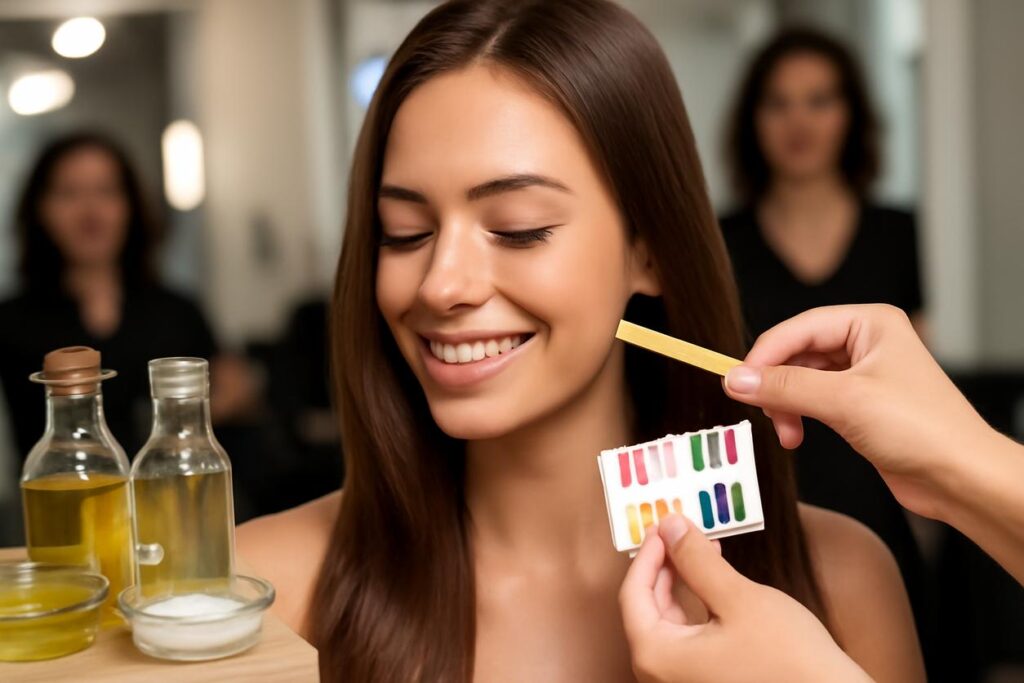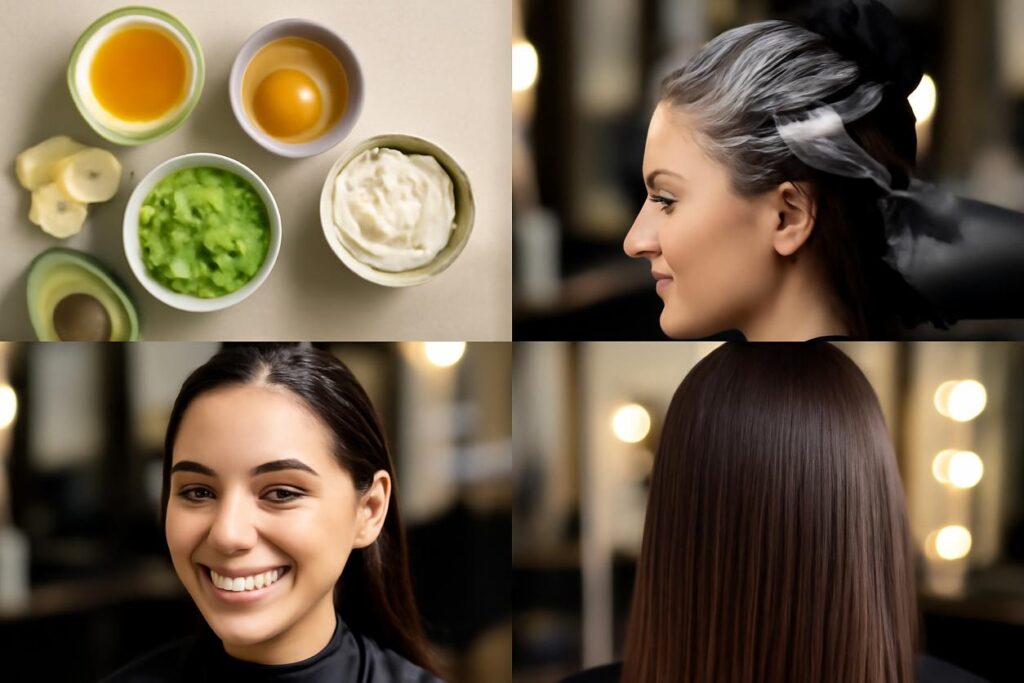The Ultimate Guide to Hair pH Balance: Unlock Shinier, Stronger Hair
Welcome to your complete guide on one of the most overlooked secrets to incredible hair: hair pH balance. If you’ve ever wondered why your hair feels dry, frizzy, or brittle despite using the best products, the answer might lie in its pH level. Understanding and managing this simple scientific concept can transform your hair care routine from a guessing game into a targeted strategy for health and shine. This guide will walk you through everything you need to know, from at-home testing to creating a simple, effective maintenance plan.
What is hair pH and why it matters
Before we dive into the specifics of hair, let’s quickly understand what pH is. In simple terms, pH stands for “potential of Hydrogen” and is a scale used to measure the acidity or alkalinity of a substance. The scale ranges from 0 to 14.
- 0-6.9 is acidic (like lemon juice or vinegar).
- 7 is neutral (like pure water).
- 7.1-14 is alkaline or basic (like baking soda or bleach).
Your hair and scalp are naturally acidic. The ideal hair pH balance for the hair shaft is around 3.67, while the scalp’s natural pH is about 5.5. This acidic environment, known as the “acid mantle,” is a protective layer that is crucial for retaining moisture and protecting your hair and scalp from bacteria and fungi. When the pH is disrupted, this protective layer is compromised, leading to a host of hair problems.
How pH influences hair texture color and strength
The pH level has a direct physical effect on the structure of your hair. Each strand of hair is covered in a protective layer of overlapping scales called the cuticle. The state of this cuticle determines how your hair looks and feels.
Influence on Texture and Strength
When your hair is at its ideal acidic pH, the cuticles lie flat and tightly sealed. This creates a smooth, even surface that reflects light, making your hair look shiny and healthy. A sealed cuticle also locks in moisture and protects the inner cortex of the hair, making it strong and elastic. Conversely, when hair is exposed to alkaline substances, the cuticles lift and open up. This creates a rough surface, leading to frizz, tangles, and a dull appearance. An open cuticle also allows moisture to escape easily, resulting in dry, brittle hair that is prone to breakage.
Influence on Hair Color
The concept of hair pH balance is especially important for color-treated hair. Chemical services like bleaching and permanent coloring are highly alkaline processes. This is intentional—the high pH is necessary to swell the hair shaft and open the cuticles so that color molecules can penetrate the cortex. However, if the pH is not properly restored to an acidic state afterward, the cuticles will remain open. This leads to color molecules washing out quickly, causing your vibrant new shade to fade prematurely.
Signs your hair pH is out of balance
Is your hair trying to tell you something? An imbalanced pH can manifest in several frustrating ways. If you’re experiencing any of the following, your hair and scalp may be too alkaline.
- Excessive Frizz and Flyaways: Open cuticles create a rough texture that we perceive as frizz.
- Dryness and Brittleness: Hair that can’t retain moisture becomes weak and snaps easily.
- Dull, Lackluster Appearance: Raised cuticles don’t reflect light well, robbing your hair of its natural shine.
- Tangles and Knots: Rough, open cuticles snag against each other, making hair difficult to comb.
- Itchy or Irritated Scalp: The scalp’s acid mantle fights off bacteria. When it’s disrupted, you might experience dandruff, itchiness, or inflammation.
- Rapid Color Fading: If your hair color seems to wash down the drain after just a few weeks, open cuticles are likely the culprit.
How to test hair pH at home step by step
While you can’t easily test the pH of your hair strands directly at home, you can test the products you use, which is the most practical way to manage your hair pH balance. All you need are some pH test strips, which are widely available online or in pharmacies.
A Step-by-Step Guide to Testing Your Products
- Gather Your Supplies: You will need your hair products (shampoo, conditioner, etc.), pH test strips, and a small amount of distilled water. It’s crucial to use distilled water because its neutral pH of 7 won’t skew your results.
- Prepare the Solution: In a clean bowl, mix a small amount of your product with a little distilled water to create a solution that is thin enough for the strip to absorb.
- Dip the Strip: Submerge the end of a pH test strip into the solution for a few seconds.
- Read the Results: Remove the strip and wait for the color to change. Compare the final color to the chart provided with your test strips to determine the product’s pH level.
Ideally, your cleansers and styling products should fall within the 4.0 to 6.0 pH range to support your hair’s natural acidity.
Daily habits that disturb pH
Many common haircare practices and environmental factors can push your hair’s pH into the alkaline zone, disrupting its natural balance.
- Using Harsh Shampoos: Many traditional shampoos use strong, alkaline detergents like Sodium Lauryl Sulfate (SLS) that can strip the hair and scalp of their natural acid mantle.
- Washing with Hard Water: The tap water in many areas is “hard,” meaning it has a high concentration of alkaline minerals like calcium and magnesium. Over time, these minerals can build up on your hair, raising its pH.
- Chemical Treatments: As mentioned, hair coloring, bleaching, relaxers, and perms are all highly alkaline processes designed to alter the hair’s structure.
- Swimming: Chlorine in swimming pools is alkaline and can be very stripping to the hair cuticle.
Restoring balance with rinses shampoos and conditioners
The good news is that restoring and maintaining a healthy hair pH balance is entirely achievable. The core strategy is to consistently use products that are on the acidic side of the pH scale.
pH-Balanced Shampoos and Conditioners
The first line of defense is choosing the right shampoo. Look for products specifically labeled as “pH-balanced” or formulated for color-treated hair, as these are typically designed to be acidic. Conditioners are almost always acidic by nature. Their primary job is to smooth and seal the hair cuticle after it has been opened during the cleansing process. This is why your hair feels so much smoother after conditioning.
The Power of Acidic Rinses
An acidic rinse, used as a final step after shampooing and conditioning, is a fantastic way to ensure your hair cuticle is fully sealed. These rinses help to remove mineral buildup from hard water, close the cuticle tightly, and restore the scalp’s acid mantle, leaving hair incredibly shiny and smooth.
Safe natural remedies and DIY pH rinses
You don’t need expensive products to maintain your hair’s pH. Some of the most effective solutions can be made right in your kitchen. Remember to always dilute acidic ingredients properly and perform a patch test before a full application.
- Apple Cider Vinegar (ACV) Rinse: This is the most popular DIY rinse for a reason. ACV has a pH of around 2-3, so it must be heavily diluted.
- Recipe: Mix 1 to 2 tablespoons of raw, unfiltered ACV with 16 ounces (2 cups) of cool water in a spray bottle or jug.
- How to Use: After shampooing and conditioning, pour or spray the mixture over your hair, focusing on the lengths. Let it sit for a minute or two, then lightly rinse with cool water. You can also leave it in for extra benefits.
- Green Tea Rinse: Green tea is packed with antioxidants and is naturally slightly acidic.
- Recipe: Brew a cup of green tea and let it cool completely.
- How to Use: Use it as a final rinse after your normal wash routine.
- Aloe Vera Juice Rinse: Aloe vera has a pH similar to our hair (around 4.5) and is also incredibly hydrating.
- Recipe: Mix one part pure aloe vera juice with two parts water.
- How to Use: Apply after conditioning as a final, soothing rinse.
A simple weekly routine to keep hair pH stable
Consistency is key. Here is a sample weekly plan you can adapt for 2025 and beyond to ensure you maintain a healthy hair pH balance.
| Frequency | Action | Purpose |
|---|---|---|
| Each Wash Day (2-3 times/week) | Use a pH-balanced shampoo and a conditioner. | Gently cleanse without stripping the acid mantle and seal the cuticle immediately. |
| Once a Week | Perform a DIY acidic rinse (like an ACV rinse) after conditioning. | Remove product and mineral buildup, and give your cuticles an extra-tight seal for maximum shine. |
| Post-Chemical Treatment | Use a pH-balancing deep conditioner or mask. | Immediately restore the hair’s acidic pH after an alkaline coloring or bleaching service to lock in color and prevent damage. |
| Daily | Apply pH-friendly leave-in products. | Protect hair from environmental stressors and maintain moisture and smoothness throughout the day. |
Product checklist what to look for and what to avoid
Navigating product labels can be confusing. Here’s a simple checklist to help you make pH-smart choices.
What to Look For:
- pH-Balanced Labels: The easiest way to find a suitable product.
- Formulas for Color-Treated Hair: These are almost always acidic to help seal the cuticle and prevent color fade.
- Key Ingredients: Look for ingredients like aloe vera, citric acid, or lactic acid, which help lower a product’s pH.
- Acidic Product Types: Conditioners, hair masks, glosses, and leave-in conditioners are generally formulated to be acidic.
What to Avoid:
- Harsh Sulfates: Ingredients like Sodium Lauryl Sulfate (SLS) and Sodium Laureth Sulfate (SLES) can be highly alkaline and stripping.
- Bar Soaps: Traditional soap is very alkaline and not suitable for hair unless it is a specifically formulated “shampoo bar” that is pH-balanced.
- Overusing Clarifying Shampoos: While useful for deep cleaning, many clarifying shampoos have a higher pH to effectively remove buildup. Use them sparingly.
When to consult a professional stylist or trichologist
While managing your hair pH balance at home can solve many issues, some conditions require professional expertise.
Consult a professional stylist for guidance on the best products for your hair type and for any chemical services. They can perform treatments to restore pH after coloring and recommend a proper at-home care regimen. For more serious or persistent issues, it’s time to see a trichologist, who is a specialist in the science of hair and scalp health. Seek their advice if you experience:
- Severe, persistent scalp conditions like dandruff, psoriasis, or seborrheic dermatitis.
- Noticeable hair loss or thinning.
- Extreme hair breakage that doesn’t improve with at-home treatments.
Common myths about hair pH debunked
There’s a lot of misinformation out there. Let’s clear up a few common myths about hair pH.
Myth 1: All-natural or “clean” products are automatically pH-balanced.
Fact: Not true. “Natural” does not equal “pH-appropriate.” For example, pure lemon juice is natural but far too acidic (pH 2) for direct use on hair, while baking soda is natural but highly alkaline (pH 9). The formulation is what matters, not just the ingredient source.
Myth 2: You need an alkaline shampoo to get your hair truly clean.
Fact: This is outdated thinking. Modern, gently acidic cleansers are highly effective at removing dirt and oil without stripping the hair’s protective acid mantle. A squeaky-clean feeling often indicates that your hair has been stripped of its natural oils, which can lead to damage.
Myth 3: Hair pH balance only matters if you have damaged or colored hair.
Fact: Maintaining the correct pH is a fundamental aspect of hair health for everyone. It is a proactive strategy to *prevent* damage, retain moisture, and keep hair strong and shiny, regardless of its current condition.
Further reading and references
For those interested in delving deeper into the science of hair care and pH, these resources offer valuable information:
- pH Explained: A comprehensive overview of the pH scale from Wikipedia.
- Hair Structure Research: A scientific article on the biology and structure of the hair follicle.
- Cosmetic Science Overview: Information on the science behind cosmetic and hair care products.
- Rich Hair UK: A resource for hair health and trichology information.






